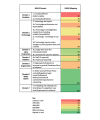Global Evidence on the Sustainability of Telemedicine in Outpatient and Primary Care During the First 2 Years of the COVID-19 Pandemic: Scoping Review Using the Nonadoption, Abandonment, Scale-Up, Spread, and Sustainability (NASSS) Framework
- PMID: 40053716
- PMCID: PMC11909490
- DOI: 10.2196/45367
Global Evidence on the Sustainability of Telemedicine in Outpatient and Primary Care During the First 2 Years of the COVID-19 Pandemic: Scoping Review Using the Nonadoption, Abandonment, Scale-Up, Spread, and Sustainability (NASSS) Framework
Abstract
Background: The rapid implementation of telemedicine during the early stages of the COVID-19 pandemic raises questions about the sustainability of this intervention at the global level.
Objective: This research examines the patient experience, health inequalities, and clinician-patient relationship in telemedicine during the COVID-19 pandemic's first 2 years, aiming to identify sustainability factors.
Methods: This study was based on a prepublished protocol using the Joanna Briggs Institute (JBI) methodology for scoping reviews. We included academic and gray literature published between March 2020 and March 2022 according to these criteria: (1) population (any group); (2) concepts (patient experience, clinician-patient relationship, health inequalities); (3) context (telemedicine in primary and outpatient care); (4) excluding studies pertaining to surgery, oncology, and (inpatient) psychiatry. We searched Ovid Medline/PubMed (January 1, 2022), Web of Science (March 19, 2022), Google/Google Scholar (February and March 2022), and others. The risk of bias was not assessed as per guidance. We used an analysis table for the studies and color-coded tabular mapping against a health care technology adoption framework to identify sustainability (using double-blind extraction).
Results: Of the 134 studies that met our criteria, 49.3% (66/134) reported no specific population group. Regarding the concepts, 41.8% (56/134) combined 2 of the concepts studied. The context analysis identified that 56.0% (75/134) of the studies referred to, according to the definition in the United Kingdom, an outpatient (ambulatory care) setting, and 34.3% (46/134) referred to primary care. The patient experience analysis reflected positive satisfaction and sustained access during lockdowns. The clinician-patient relationship impacts were nuanced, affecting interaction and encounter quality. When mapping to the nonadoption, abandonment, scale-up, spread, and sustainability (NASSS) framework, 81.3% (109/134) of the studies referenced the innovation's sustainability. Although positive overall, there were some concerns about sustainability based on quality, eHealth literacy, and access to health care for vulnerable migrants and the uninsured.
Conclusions: We identified confusion between the concepts of patient experience and patient satisfaction; therefore, future research could focus on established frameworks to qualify the patient experience across the whole pathway and not just the remote encounter. As expected, our research found mainly descriptive analyses, so there is a need for more robust evidence methods identifying impacts of changes in treatment pathways. This study illustrates modern methods to decolonize academic research by using gray literature extracts in other languages. We acknowledge that the use of Google to identify gray literature at the global level and in other languages has implications on reproducibility. We did not consider synchronous text-based communication.
Trial registration: Open Science Framework 4z5ut; https://osf.io/4z5ut/.
Keywords: NASSS; PRISMA; ambulatory care; clinician-patient relationship; global health; gray literature; health inequalities; outpatients; pandemic; patient experience; primary care; telemedicine.
©Daniela Valdes, Ankit Shanker, Ghofran Hijazi, Daniel Opoku Mensah, Tahir Bockarie, Ioana Lazar, Siti Aishah Ibrahim, Hamid Zolfagharinia, Rob Procter, Rachel Spencer, Jeremy Dale, Armina Paule, Liam Jonathon Medlin, Keerthana Tharuvara Kallottil. Originally published in the Interactive Journal of Medical Research (https://www.i-jmr.org/), 28.02.2025.
Conflict of interest statement
Conflicts of Interest: At the time of publication, DV, TB, and HZ worked in the UK National Health Service in the United Kingdom. The research was undertaken independently of DV’s, TB’s, and HZ’s occupations and does not represent the views of their employers. The remaining authors declare no conflict of interest.
Figures



References
-
- WHO Director-General's opening remarks at the media briefing on COVID-19 - 11 March 2020. World Health Organization. 2020. Mar 11, [2021-02-20]. https://tinyurl.com/tn4rtbse .
-
- Rational use of personal protective equipment (PPE) for coronavirus disease (COVID-19) World Health Organization. 2020. Mar 19, [2021-06-08]. https://apps.who.int/iris/bitstream/handle/10665/331498/WHO-2019-nCoV-IP... .
-
- Chersich MF, Gray G, Fairlie L, Eichbaum Q, Mayhew S, Allwood B, English R, Scorgie F, Luchters S, Simpson G, Haghighi MM, Pham MD, Rees H. COVID-19 in Africa: care and protection for frontline healthcare workers. Global Health. 2020 May 15;16(1):46. doi: 10.1186/s12992-020-00574-3. https://globalizationandhealth.biomedcentral.com/articles/10.1186/s12992... 10.1186/s12992-020-00574-3 - DOI - DOI - PMC - PubMed
-
- Wherton J, Greenhalgh T. Evaluation of the Near Me video consulting service in Scotland during COVID-19, 2020: Summary Report. Scottish Government. 2021. Mar, [2024-11-06]. https://tinyurl.com/3nmavy8m .
Publication types
LinkOut - more resources
Full Text Sources
Research Materials
Miscellaneous

